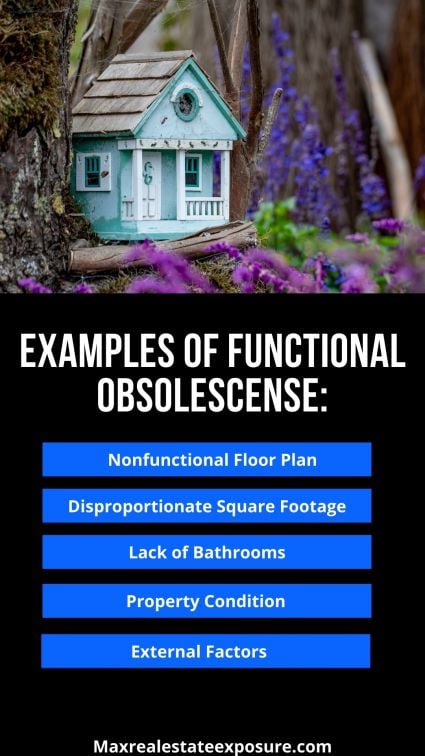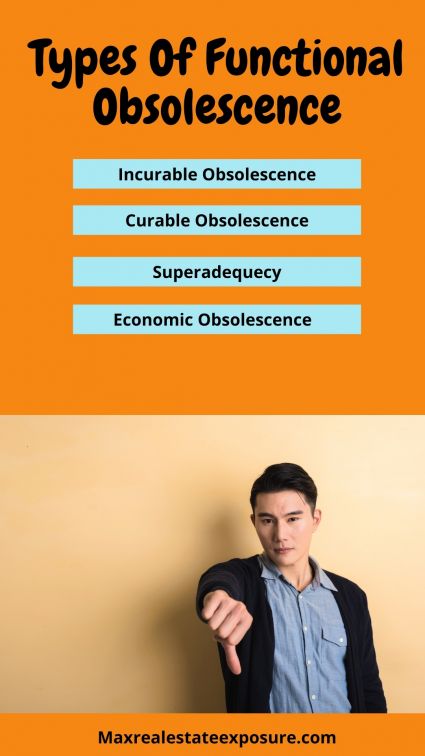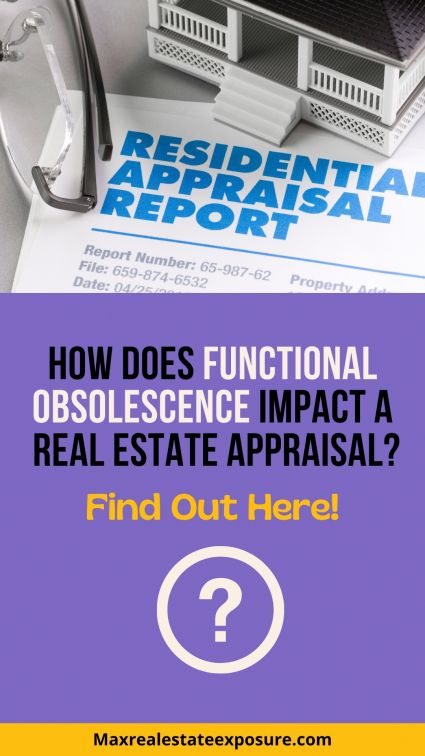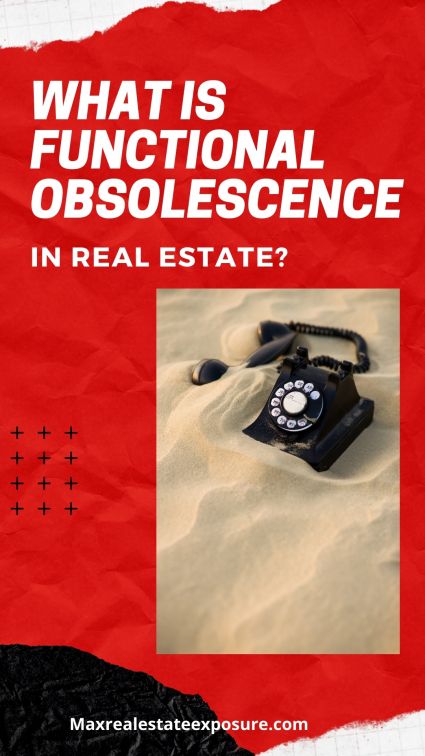 How Functional Obsolescence Real Estate Impacts Home Values
How Functional Obsolescence Real Estate Impacts Home Values
Being functionally obsolete can happen in all walks of life. Examples would be a payphone, a heavy-tube television, and a cassette tape.
At one time, these things were useful but now have been replaced by better new technology. Their economic life has come to an end.
If you are considering investing in property, you might have stumbled across the phrase functional obsolescence. When making a property investment, it’s a situation you’ll want to avoid to ensure you stay profitable.
While you might have heard this phrase used in other industries, what does functional obsolescence in real estate mean?
Let’s examine the meaning as it applies to real estate. Not understanding obsolescence when purchasing a home could lead to a buying mistake you’ll regret.
What is Functional Obsolescence in Real Estate?
Functional obsolescence is a term that has been applied to many different sectors, often used to refer to outdated technology.
Newer versions of tech devices eventually leave older models functionally obsolete.
But in real estate, it is when a home doesn’t meet market expectations on a functional level. A feature of the house might be outdated and not easily improved. This reduces the property’s desirability and, in turn, its value.
Those in the real estate industry consider this to be the definition of functional obsolescence. Impairing the functional capacity of the property leads to a loss of value as prospective buyers see a lack of utility.
This is important when investing in property as it means a big difference to your bottom line. Whether renting out the property or renovating and flipping, this is something you must consider.
When homes are constructed that do not meet recognized utility, they suffer in the real estate marketplace. Features that are considered not practical or desirable end up turning away home buyers.
What Are Functional Obsolescence Examples?
What could make a property functionally obsolete in real estate?
Let’s look at some common examples to understand functional obsolescence in real estate better.
An Unfunctional Floor Plan
An undesirable floor plan is one of the worst kinds of functional obsolescence in real estate. A functionally obsolete floor plan can make selling a home more challenging by shrinking the buyer pool.
Supply and demand are one of the most significant factors in real estate market value.
When a floor plan is seen as undesirable, it deters home buyers from making an offer. Some examples of functional obsolescence when it comes to floor plans would be the following:
- Walking through a formal dining room to get to your master bedroom ensuite. A poor architectural design was not thought through carefully.
- Having to walk through one bedroom to get to another.
- The home’s laundry room is located inside a secondary bedroom. This is another feature that would be considered a poor design.
- The bedrooms are on one level of the home, and the only bathroom is located on another level.
- When a home has a low ceiling height which is commonly found in older homes.
A lousy floor plan is one of the worst forms of functional obsolescence because, often, the drawbacks can’t be changed.
An outdated design feature is not uncommon at all in an old house. A good example is having a bunch of small choppy rooms. It is a type of real estate obsolescence that is quite common.
While learning about the history of a house can be a cool thing to research, it can be costly if you overlook obsolescence.
Market tastes are constantly shifting, so it is not unexpected that a property built a few hundred years ago would have some functional obsolescence.
Square Footage
 If too many bedrooms are packed into insufficient space, the home could be functionally obsolete.
If too many bedrooms are packed into insufficient space, the home could be functionally obsolete.
For example, rooms could be too small if a property is under 1,000 square feet but has three bedrooms.
While they can still technically be used as bedrooms, they wouldn’t offer enough room for most people.
The space in a home not being proportionately sound is an excellent example of physical obsolescence.
A Lack of Bathrooms
The home will be far from ideal if a 4 or 5-bedroom property only has a single bathroom. Potential buyers or renters of a property like that will likely use most or all of the bedrooms.
Most home purchasers will expect and need more than just one bathroom, and because of that, potential buyers or tenants will keep searching.
The lack of bathrooms is real estate obsolescence in many antique homes built centuries ago. Adding a bathroom is one of the best ways of fixing functional obsolescence in some older homes.
Market standards today call for larger homes to have multiple bathrooms, including a half bath on the first floor and numerous baths on the second floor.
Property Condition
If a home isn’t well maintained, it can be functionally obsolete. If the standard of upkeep in the neighborhood is good, a property that has missed out on repairs and upgrades will undoubtedly stand out, but not in a good way.
On the other hand, a home in good condition blends in with the rest of the properties.
With more desirable options, homes that haven’t been maintained as they should be will usually be overlooked and less desirable to buyers.
Physical obsolescence can lead to a decline in a property’s value due to gross mismanagement of expected regular maintenance.
External Factors Can Lead to Functional Obsolescence Real Estate
External factors can easily lead to a loss of property value. Undesirable design features outside a home can lead to losing a property’s desirability.
When a property owner does not keep up with the maintenance of their home, it could lead to physical deterioration. This kind of external obsolescence would lead to another form of depreciation.
Other external factors that can influence the functional obsolescence of a subject property include noise pollution, freeway noise, and soaring crime rates.
If the traffic has increased on the street, it will make the property less desirable. It will make it more difficult for the owner or renters to use the driveway. It will also put off families from buying or renting.
Busy roads and children don’t mix well, so families will be less willing to move in. The same can be said for having a significant amount of crime in a city or town. External obsolescence such as this will cause market demand to fall.
These items should be researched thoroughly during the due diligence period. Due diligence in real estate is essential to make a sound buying decision.
Some other things will bring down a property’s market value.
The Four Different Types of Functional Obsolescence Real Estate
 There isn’t simply one type of functional obsolescence. These factors can be divided into three different categories.
There isn’t simply one type of functional obsolescence. These factors can be divided into three different categories.
The type of functional obsolescence that applies to the property can be the difference between something that can be dealt with or an investment set to lose your money.
Incurable Functional Obsolescence
Incurable obsolescence is often something that is entirely out of the control of the homeowner. This could be a bustling road or the neighborhood’s deterioration.
While these are issues that can sometimes happen gradually when you own a property, they should be easy to see when looking to buy an investment home.
Though a home suffering from incurable obsolescence might appear to be a good bargain, that could be a mistake. You need to be aware that it is unlikely that there is anything you can do to turn around the situation in some scenarios.
There can also be some obsolescences that could be cured but are either too expensive or impractical to fix.
These situations can be more challenging to recognize as you might buy an investment property on the understanding that it needs certain repairs.
Only later discovering that the cost of those repairs is higher than expected, leaving you with a property that you will likely lose money on if renovated.
Curable Functional Obsolescence
The owner can cure many functional obsolescence situations. If, for example, the home hasn’t been well maintained for many years, this should be able to be fixed. Some abandoned properties fit this description.
The cost of the improvements, however, should be taken into consideration.
It would be best to be sure that you are clear on the costs involved and know the renovation expenses before you purchase. Contractor quotes should give you a more accurate understanding of the repair cost of bringing the home back to its standard.
Physical neglect and physical wear can at least be fixed. Functional obsolescence real estate is much better when curable than not.
Superadequacy
It is possible to do too much to a property for the neighborhood it is located in. Doing so is what’s referred to as super adequacy.
Superadequacy is a form of functional obsolescence caused by something associated with the property that exceeds market requirements but doesn’t add to the value vs. its cost.
For example, if you add a lavish swimming pool to a property that costs $200,000 due to extravagant features, you will unlikely recoup your initial investment.
You may receive some of the value, mainly if you sell luxury real estate.
If you improve the property above the norm in the neighborhood, making a profit or even getting your money back could be challenging.
Economic Obsolescence
The last type of functional obsolescence is economy. Many people wonder about economic obsolescence and how it impacts the value of a property. What is economic obsolescence? It is when you lose value due to economic factors.
In real estate, home values could suffer due to market forces such as supply and demand. What is an example of economic obsolescence for a homeowner?
Increased crime rates, a nearby busy highway, large powerlines, or some other undesirable improvement could influence economic obsolescence for an individual property.
These are all considered common causes of economic obsolescence. If there are an unusual amount of buyers purchasing foreclosures surrounding the property, this could also be a form of economic obsolescence that could affect home values.
Likewise, if the development of low-income housing was added to a higher-end neighborhood, this could be detrimental to home values. Buyers would not favor low-income apartments being added to luxury areas.
Can a New Home Have Functional Obsolescence?
Yes, it is certainly possible. If you were buying new construction in a luxury neighborhood, it would be expected all the homes would have similar features. If the builder decided to sell one of their lots, a buyer could construct the house obsoletely.
For example, if a buyer installed Formica countertops in the kitchen and baths when all the other homes had stone, this would be a significant detraction. Imagine if this homeowner also put linoleum in all the bathrooms and carpet in the dining room and had no wood moldings.
When the homeowner decided to sell their home, it would already be functionally obsolete. Buyers would be expecting something completely different.
Another example would be all of the square footage of the homes being similar other than the white elephant that was allowed to be built.
Now and then, there will be a home that sticks out like a sore thumb because the neighborhood did not have restrictive covenants. It’s the perfect example of why so many communities have house covenants.
How Much of an Impact Does Functional Obsolescence Have?
 Functional obsolescence can become an issue when you get a real estate appraisal on the property. All situations are different, of course, but generally, curable obsolescence will be less of a problem than incurable.
Functional obsolescence can become an issue when you get a real estate appraisal on the property. All situations are different, of course, but generally, curable obsolescence will be less of a problem than incurable.
There are numerous things real estate appraisers look at with an appraisal, and all types of obsolescence are one of them.
With super adequacy, it could lead to the investor not selling the home for enough to cover their investment costs. How much of a loss the investor might face will depend on the valuation from the appraiser.
This situation can be more of a problem if the appraiser uses comparative sales data, which is usually the case.
If you are in this scenario, it would be better for the appraiser to base the value on the replacement cost of the property instead. This will make more sense with super adequacy since there will not be other homes that offer comparable sales information.
This situation occurs quite often when buying the best home in a neighborhood.
Real Estate Appraisers Will Discount Functional Obsolescence
Functional obsolescence in an appraisal happens from time to time.
Whether an appraiser uses the cost approach or the sales comparison approach if functional obsolescence exists, they will consider this when determining market value.
Appraisers will follow the Dictionary of Real Estate Appraisal, fifth edition, for the definition of obsolescence.
It is one of the many factors used to assemble a house appraisal. How much the real estate appraiser discounts will be property dependent and the level of functional depreciation.
Appraisers will use comparable properties and then make adjustments based on the severity. The types of obsolescence will be outlined in their appraisal report.
Final Thoughts on Functional Obsolescence Real Estate
Whether you are a prospective homebuyer or a real estate investor growing your property portfolio, you must understand and be alert to functional obsolescence. It could be the difference between a profitable investment or a mistake you regret.
While no two investment properties are the same, you should stay clear of obsolescence. Knowledge of functional obsolescence is another tool to ensure your investments remain profitable.
Hopefully, you now have a much better understanding of what obsolete means.
About the author: Bill Gassett, a nationally recognized leader in his field, provided the above Real Estate information on what functional obsolescence Real Estate is. Bill can be reached via email at billgassett@remaxexec.com or by phone at 508-625-0191. Bill has helped people move in and out of Metrowest towns for the last 37+ Years.
Are you thinking of selling your home? I am passionate about Real Estate and would love to share my marketing expertise!
I service Real Estate Sales in the following Metrowest MA towns: Ashland, Bellingham, Douglas, Framingham, Franklin, Grafton, Holliston, Hopkinton, Hopedale, Medway, Mendon, Milford, Millbury, Millville, Natick, Northborough, Northbridge, Shrewsbury, Southborough, Sutton, Wayland, Westborough, Whitinsville, Worcester, Upton, and Uxbridge MA.

